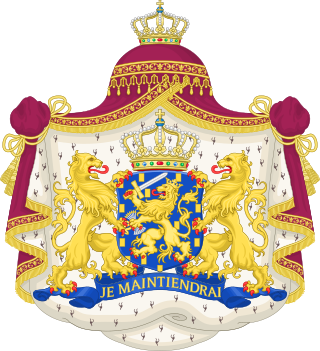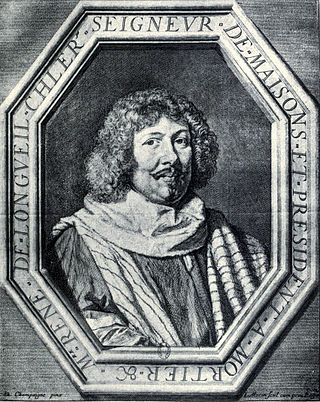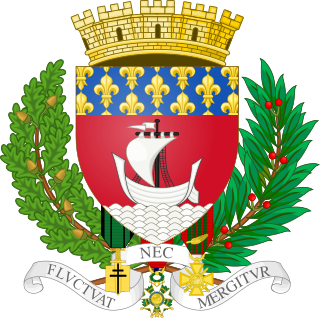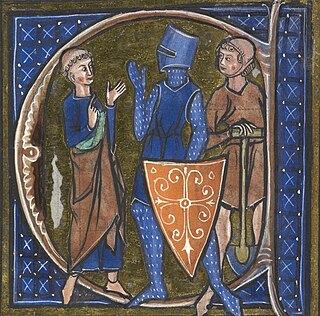Related Research Articles

Morganatic marriage, sometimes called a left-handed marriage, is a marriage between people of unequal social rank, which in the context of royalty or other inherited title prevents the principal's position or privileges being passed to the spouse, or any children born of the marriage. The concept is most prevalent in German-speaking territories and countries most influenced by the customs of the German-speaking realms.

Belgium is a constitutional, hereditary and popular monarchy. The monarch is titled King of the Belgians and serves as the country's head of state and commander-in-chief of the Belgian Armed Forces. There have been seven Belgian monarchs since independence in 1830.

The House of Orange-Nassau is the current reigning house of the Netherlands. A branch of the European House of Nassau, the house has played a central role in the politics and government of the Netherlands and elsewhere in Europe, particularly since William the Silent organised the Dutch Revolt against Spanish rule, which after the Eighty Years' War (1568–1648) led to an independent Dutch state. William III of Orange led the resistance of the Netherlands and Europe to Louis XIV of France, and orchestrated the Glorious Revolution in England that established parliamentary rule. Similarly, Queen Wilhelmina of the Netherlands was instrumental in the Dutch resistance during World War II.

A viscount or viscountess is a title used in certain European countries for a noble of varying status. The status and any domain held by a viscount is a viscountcy.

Prince of Orange is a title originally associated with the sovereign Principality of Orange, in what is now southern France and subsequently held by sovereigns in the Netherlands.
There is significant disagreement among historians of the French Revolution as to its causes. Usually, they acknowledge the presence of several interlinked factors, but vary in the weight they attribute to each one. These factors include cultural changes, normally associated with the Enlightenment; social change and financial and economic difficulties; and the political actions of the involved parties. For centuries, the French society was divided into three estates or orders.

Baudricourt is a commune in the Vosges department in Grand Est in northeastern France.

The French nobility was a privileged social class in France from the Middle Ages until its abolition on 23 June 1790 during the French Revolution.
Hereditary titles, in a general sense, are nobility titles, positions or styles that are hereditary and thus tend or are bound to remain in particular families.

René de Longueil, marquis (1658) de Maisons (1596–1677), le président de Maisons, was Surintendant des Finances under Louis XIV. He built the Château de Maisons.

Princess Anne of Bourbon-Two Sicilies, Dowager Duchess of Calabria is the widow of Infante Carlos, Duke of Calabria. She is the third daughter and fifth child of Henri, Count of Paris, Orléanist claimant to the defunct French throne, and his wife Princess Isabelle of Orléans-Braganza.

The flag and coat of arms of Normandy are symbols of Normandy, a region in north-western France.

The coat of arms of the city of Paris shows a silver sailing ship on waves of the sea in a red field, with a chief showing the Royal emblem of gold-on-blue fleur-de-lis. Originally introduced in the 14th century, its current form dates to 1853. The city motto is Fluctuat nec mergitur. The traditional colors of the city of Paris are red and blue.

Gentry are "well-born, genteel and well-bred people" of high social class, especially in the past. Gentry, in its widest connotation, refers to people of good social position connected to landed estates, upper levels of the clergy, or "gentle" families of long descent who in some cases never obtained the official right to bear a coat of arms. The gentry largely consisted of landowners who could live entirely from rental income or at least had a country estate; some were gentleman farmers. In the United Kingdom, the term gentry refers to the landed gentry: the majority of the land-owning social class who typically had a coat of arms but did not have a peerage. The adjective "patrician" describes in comparison other analogous traditional social elite strata based in cities, such as the free cities of Italy and the free imperial cities of Germany, Switzerland, and the Hanseatic League.

The House of Monpezat is a French old bourgeois family from the Province of Béarn associated with the Danish Royal Family by marriage after 1967, when Henri de Laborde de Monpezat wed Princess Margrethe of Denmark, then the heir presumptive of the ruling House of Glücksburg, who was subsequently the Queen of Denmark as Margrethe II. The current Danish monarch, King Frederik X is agnatically a Monpezat.

In heraldic achievements, the helmet or helm is situated above the shield and bears the torse and crest. The style of helmet displayed varies according to rank and social status, and these styles developed over time, in step with the development of actual military helmets. In some traditions, especially German and Nordic heraldry, two or three helmets may be used in a single achievement of arms, each representing a fief to which the bearer has a right. For this reason, the helmets and crests in German and Nordic arms are considered essential to the coat of arms and are never separated from it.

Nobility is a social class found in many societies that have an aristocracy. It is normally ranked immediately below royalty. Nobility has often been an estate of the realm with many exclusive functions and characteristics. The characteristics associated with nobility may constitute substantial advantages over or relative to non-nobles or simply formal functions, and vary by country and by era. Membership in the nobility, including rights and responsibilities, is typically hereditary and patrilineal.
Most of the members of the Capetian dynasty bore a version of the arms of France. The arms of France were adopted by the Capetian kings only in the twelfth century. Consequently, the cadet branches that had branched off in earlier periods bore entirely different arms.

The coat of arms of Lyon, the ancient capital of the Gauls, reflects the rich history of the city across different periods of its existence and the power that has exercised authority over the city. It was created in 1320, although the current version, which dates from 1859, reprises the form that it had before the end of the Ancien Régime after having undergone several temporary modifications.

Heraldry is the system of visual identification of rank and pedigree which developed in the European High Middle Ages, closely associated with the courtly culture of chivalry, Latin Christianity, the Crusades, feudal aristocracy, and monarchy of the time. Heraldic tradition fully developed in the 13th century, and it flourished and developed further during the Late Middle Ages and the Early Modern period. Originally limited to nobility, heraldry is adopted by wealthy commoners in the Late Middle Ages. Specific traditions of Ecclesiastical heraldry also develop in the late medieval period. Coats of arms of noble families, often after their extinction, becomes attached to the territories they used to own, giving rise to municipal coats of arms by the 16th century.
References
- 1 2 "Blason" (in French). Larousse. n.d. Retrieved 29 September 2014.
- ↑ Spitters, Thomas H. (2005). Vocabulaire Général de la Littérature Française Du XXème Siècle (in French). North Carolina, USA: Lulu. p. 21. ISBN 9781411632233.
- ↑ Histoire de France, 1750-1995: Société, culture [The History of France, 1750-1995: Society, culture] (in French). Vol. II. Toulouse, France: Presse Universitaires du Mirail. 1996. p. 156. ISBN 2858162751 . Retrieved 29 September 2014.
- 1 2 Russell Major, J. (1997). From Renaissance Monarchy to Absolute Monarchy: French Kings, Nobles, and Estates. Maryland, UK: Johns Hopkins University Press. p. 70. ISBN 9780801856310.
- ↑ Bush, M. L. (1988). Rich Noble, Poor Noble. Manchester, UK: Manchester University Press. p. 93. ISBN 9780719023811.
- ↑ "Redorer son blason". Collins Dictionary. n.d. Retrieved 29 September 2014.
- ↑ "Les maires FN veulent redorer leur blazon" [FN Mayors want to improve their image] (in French). Le Point. 6 September 2014. Retrieved 29 September 2014.